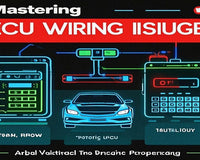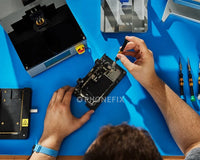ECU is this component that controls your car's engine. ECU makes real - time adjustments to engine parameters like fuel injection, ignition timing, and idle speed. A malfunctioning ECU chip can lead to a wide range of problems, from poor fuel economy to engine misfires and even complete engine failure in extreme cases, you will have trouble operating your vehicle. Testing whether your car's ECU (Engine Control Unit) is faulty can be a complex but crucial task.
What are the symptoms of ECU failure?
1. Engine Misfires: If your engine is randomly misfiring, and you've ruled out issues with spark plugs, ignition coils, and fuel injectors, the ECU could be at fault. The ECU controls the ignition and fuel delivery, and a problem with the ECU chip can disrupt this precise coordination.
2. Reduced Fuel Efficiency: A significant drop in your car's fuel mileage that isn't explained by your driving habits or other known factors may indicate an ECU problem.
3. Check Engine Light: The most obvious sign is the illumination of the check engine light. While this light can indicate numerous issues, a bad ECU is one of the potential causes. However, it's important to note that the check engine light doesn't specifically tell you that the ECU is faulty; further testing is required.
4. Starting Problems: Difficulty starting your car, such as extended cranking without the engine firing up, can be due to an ECU problem. The ECU controls the starting sequence, including fuel injection and ignition, and a malfunctioning ECU chip can disrupt this process.
How to Test Your Car's ECU?
Use an OBD - II Scanner.
Most modern cars are equipped with an On - Board Diagnostics II (OBD - II) port, usually located under the dashboard. Connect an V519 OBD2 scanner to this port. The scanner will read the trouble codes stored in the ECU. While these codes won't always directly tell you that the ECU is bad, they can point you in the right direction.
Visual Inspection.
Locate the ECU in your vehicle. Look for signs of physical damage, such as burnt components, cracked circuit boar s, or corroded connectors. A burnt smell near the ECU can also be a telltale sign of internal problems.
Testing the Power Supply.
Use UT890D+ multimeter to test the power supply to the ECU. Disconnect the ECU connector and set the multimeter to the voltage measurement mode. Probe the appropriate power pins on the connector according to the vehicle's service manual. 
Testing for a bad car ECU can be a challenging process, especially when dealing with the sensitive ECU chip. By paying attention to the signs of a malfunctioning ECU and using the testing methods described above, you can start to diagnose whether the ECU is the root cause of your vehicle's problems. If you're unsure performing these tests yourself, it's always a good idea to consult a professional automotive technician who has the expertise and specialized equipment to accurately diagnose and repair ECU - related issues.
How to Test If Your Engine Control Unit Is Malfunctioning?










